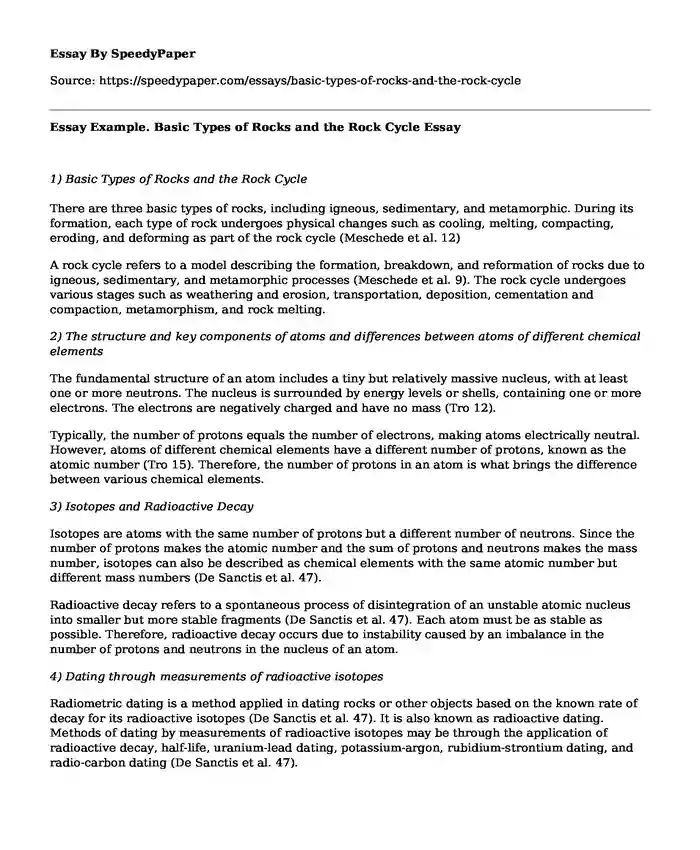1) Basic Types of Rocks and the Rock Cycle
There are three basic types of rocks, including igneous, sedimentary, and metamorphic. During its formation, each type of rock undergoes physical changes such as cooling, melting, compacting, eroding, and deforming as part of the rock cycle (Meschede et al. 12)
A rock cycle refers to a model describing the formation, breakdown, and reformation of rocks due to igneous, sedimentary, and metamorphic processes (Meschede et al. 9). The rock cycle undergoes various stages such as weathering and erosion, transportation, deposition, cementation and compaction, metamorphism, and rock melting.
2) The structure and key components of atoms and differences between atoms of different chemical elements
The fundamental structure of an atom includes a tiny but relatively massive nucleus, with at least one or more neutrons. The nucleus is surrounded by energy levels or shells, containing one or more electrons. The electrons are negatively charged and have no mass (Tro 12).
Typically, the number of protons equals the number of electrons, making atoms electrically neutral. However, atoms of different chemical elements have a different number of protons, known as the atomic number (Tro 15). Therefore, the number of protons in an atom is what brings the difference between various chemical elements.
3) Isotopes and Radioactive Decay
Isotopes are atoms with the same number of protons but a different number of neutrons. Since the number of protons makes the atomic number and the sum of protons and neutrons makes the mass number, isotopes can also be described as chemical elements with the same atomic number but different mass numbers (De Sanctis et al. 47).
Radioactive decay refers to a spontaneous process of disintegration of an unstable atomic nucleus into smaller but more stable fragments (De Sanctis et al. 47). Each atom must be as stable as possible. Therefore, radioactive decay occurs due to instability caused by an imbalance in the number of protons and neutrons in the nucleus of an atom.
4) Dating through measurements of radioactive isotopes
Radiometric dating is a method applied in dating rocks or other objects based on the known rate of decay for its radioactive isotopes (De Sanctis et al. 47). It is also known as radioactive dating. Methods of dating by measurements of radioactive isotopes may be through the application of radioactive decay, half-life, uranium-lead dating, potassium-argon, rubidium-strontium dating, and radio-carbon dating (De Sanctis et al. 47).
Works Cited
De Sanctis, Enzo, Stefano Monti, and Marco Ripani. "Radioactivity and Penetrating Power of Nuclear Radiation." Energy from Nuclear Fission. Springer, Cham, 2016. 39-87. https://link.springer.com/chapter/10.1007/978-3-319-30651-3_2
Meschede, Martin, and Laurence N. Warr. "Rocks and the Geological Record." The Geology of Germany. Springer, Cham, 2019. 9-18. https://link.springer.com/chapter/10.1007/978-3-319-76102-2_3Tro, Nivaldo J., et al. Chemistry: A molecular approach. Boston, MA: Pearson, 2017.
Cite this page
Essay Example. Basic Types of Rocks and the Rock Cycle. (2023, May 07). Retrieved from https://speedypaper.net/essays/basic-types-of-rocks-and-the-rock-cycle
Request Removal
If you are the original author of this essay and no longer wish to have it published on the SpeedyPaper website, please click below to request its removal:
- Essay Example on the Examining the Activities of the Green Party
- Free Essay on People's Culture for Everyone
- Why Lack of Literacy Is a Problem - Cause and Effect Essay
- Essay Sample: Comparison of Mexico and Japan
- Essay Sample: How Do Mindfulness and Meditation Help in Getting a Good Sleep?
- Free Essay on the US/European Sanctions Against Russian Brought China and Russia Closer Together Economically
- Essay Example: Critical Evaluation of Qualitative and Quantitative Research
Popular categories





